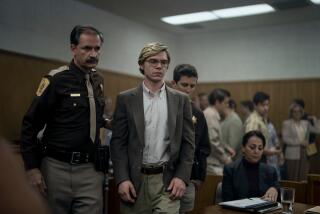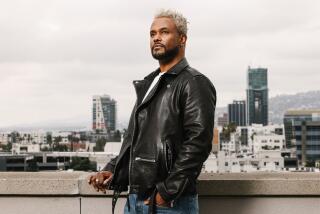Stuart Murder Shreds White Myths of Racial Harmony, Revealing Black Reality : Underside: The black view of Charles Stuart’s criminal brilliance is in the way he was able to prey upon white fear and bigotry.
- Share via
BOSTON — Following the endless ripples of Charles Stuart’s dive into the Mystic River, there remain two views to a kill--mainstream society’s portrayals on the one hand and the undercurrent of black community perspectives on the other. The bizarre sequence of events split all Boston: the point-blank murder of a pregnant white woman and the wounding of her husband as they drove from a birthing class; the sweeping manhunt through the city’s mean streets for an anonymous black killer, and the dramatic suicide that brought Stuart’s criminal hoax to the surface.
But there is an underside to the myths that masked Stuart’s plot, a quiet and terrible understanding that many urban blacks know all to well will not die with him. The feeding frenzy that sent white politicians railing, the police rampaging and the press ravaging relied on a diet of myths about good and evil, rich and poor and white and black.
For many blacks, the perspective is different. The view from down under revealed a reality in which our lives, losses and communities once again meant less than those of the mainstream white Establishment. Yet in the eternal damnation of American race relations, it is critical that the views coalesce if ever we are to see the way out of these crises.
Following the 1989 murder of Yusef Hawkins in Bensonhurst, David Dinkins, campaigning for mayor of New York, said a mayor sets the tone for a city. The tone in Boston was set on Oct. 23 as viewers watched Mayor Raymond L. Flynn, in a sweat suit, pacing the halls of the intensive-care unit with late-night camera crews. By morning, Carol Stuart was dead. The news in Boston was that Flynn might declare a state of emergency. Republican legislators had already called for reinstatement of the death penalty, and Democratic gubernatorial candidate Frank Belotti promised to pull the switch himself. Within weeks of William Bennett’s arrest for the murder, it seemed Belotti might get his chance.
While politicians and the media eagerly accepted Stuart’s tale, many from down under hungered for answers to our questions. What yuppie couple drives through an unsafe neighborhood without locking their doors? How often does a crazed crack addict scheme to hijack a car stopped at a busy intersection? If Bennett’s fear was that Stuart, watching him in the rear-view mirror, was a cop, why didn’t he shoot him? Why would a felon brag aloud about his crimes during one of Boston’s greatest manhunts?
But such inquiries could barely come up from down under in the immediate aftermath of the murder. Mainstream Boston was engrossed in pages upon pages of Stuart family lore, infinite press angles on the human sides of loss. We met their friends. We took long looks through their photo albums. We cried over Stuart’s love letter read at his wife’s funeral. Every fantasy was indulged. The you-and-me couple from Revere epitomized everything up-and-coming, the American dream snuffed out by a black savage on a dark detour through hell.
But back underground, the reality that the Stuarts were “them,” not “us,” struck hard. While Mission Hill residents held candlelight vigils for Carol at neighborhood churches, their mourning was accompanied by stop-and-frisk sweeps outside. Constitution be damned: A black man was responsible, so Flynn called out 100 additional cops and all available detectives. Even the dogs were out. Like Washington Heights in New York and South-Central Los Angeles, Mission Hill was on the list of urban war zones.
Somehow, in logic of the mainstream, Greater Roxbury and Mission Hill were responsible. James Moody, a black man who died of gunshot wounds just hours before Carol Stuart, was responsible. Alan Swanson, a black, homeless man who spent three weeks as a suspect in jail because he wore a black sweat suit and squatted in the Mission Hill projects, was responsible.
Nightsticks at our back, asphalt to our lips, “nigger” in our ears: We would all go down with Willie Bennett.
Of course there is no united black “underground” opinion--only what is forced on us as unwilling adversaries in crime-waves-turned-race-wars. Whatever our individual differences, blacks are all rounded up with the usual suspects when the crime is right--as I have learned from experience.
Locked into race by pride and accident, we are compelled toward the natural comparisons of public pain. Like the black woman in the Bronx, raped and thrown down an elevator shaft the night the Central Park jogger was attacked. Like the black grandmother in Los Angeles, killed by gang gunfire days after an Asian woman’s death in Westwood touched off the first million-dollar police sweeps.
Even our fictional public pain hails from the underside. Discussions following Spike Lee’s movie, “Do the Right Thing,” often revealed that white viewers saw the crisis peak in Mookie’s destruction of Sal’s pizza window, while most blacks saw the climax in Radio Raheem’s death at the hands of police.
Stuart’s leap, on Jan. 4, drowned few myths in the mainstream. If history is written by the victors, then reality is reported by its progeny. For many blacks, it seemed the press mourned the passing of an icon in the city’s historical memory: a local couple who, but for the interruption of race, had attained the American dream. Yet it went further. Stuart alone, said the media, had shattered “racial peace” in Boston.
But it was clear that this--or any--city could not have both: mourn the passing of a cherished fantasy and grieve the loss of some fabled racial harmony. The very non-existence of racial peace made possible the cherished ideal of pristine yuppies escaping to the good life. That--and a self-inflicted stomach wound--was Charles Stuart’s criminal brilliance.
Outraged black leaders immediately stepped up to make bold the contradiction, and to demand apologies from the mayor, the police and the media. The mayor said Stuart owed the city an apology.
In the confusion, the press measured the reasonableness of the demands against the credibility of the messengers. A circus was described: “rabble rousers,” “opportunists” and “so-called intellectuals” had joined with “legitimate community representatives” to “howl” at the mayor. Some writers even went to great lengths to remind the public what a bad guy Bennett really was.
From the other side of the color line, the undercurrent swelled.
A healing vigil held at the same church in Mission Hill attracted three times the crowd it had before. In the night, groups of black youths, enraged during an arrest in nearby Jamaica Plain, hurled Molotov cocktails at police cars. Live from Mission Hill, black and Latino teen-agers appeared on the evening news to recount the brutalities they had endured. Black elected officials and community activists defended a constituency accustomed to the indiscriminate brutality of both violent crime and state power. Everywhere the talk of apology could be heard.
Society’s prevention of senseless inhumanity may begin with equal recognition of all humanity. Those trapped on the underside insist, like Shakespeare’s Shylock in “The Merchant of Venice,” that humanity extends to all. Boston’s African-American community, like so many communities of color, demands an equal valuation of its tragic losses.
While Flynn would not apologize to the community as a whole, he offered one to Bennett’s mother during a visit to the Mission Hill Projects. Again, there were two views of his gesture.
“My mother offered him a chair to sit in, but he didn’t want to sit down,” said Willie’s brother. “He acted like my mother’s home wasn’t good enough for him.”
The deep hurt inflicted by the Stuart affair will linger here and beyond for some time. Short-term remedies--state commissions to investigate civil rights violations and civil charges against policemen alleged to have coerced witness affidavits against Bennett--will help heal the moral and physical wounds of a battered populace.
But the underside must be understood. That the Stuart murder played a major role in killing a well-needed development project in Greater Roxbury shows that we are not only a community whose perspectives comprise an undercurrent, but we are also one whose needs reflect an underclass.
The promise of healing created by this tragedy is a serious challenge to status quo damage-control measures. A reinvestment of conscience and commitment may be necessary before both sides see the same cities we live in.
More to Read
Get the L.A. Times Politics newsletter
Deeply reported insights into legislation, politics and policy from Sacramento, Washington and beyond. In your inbox twice per week.
You may occasionally receive promotional content from the Los Angeles Times.










